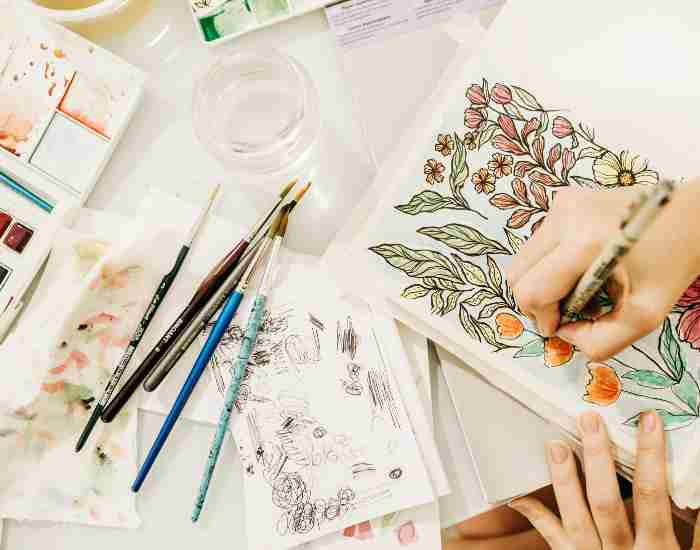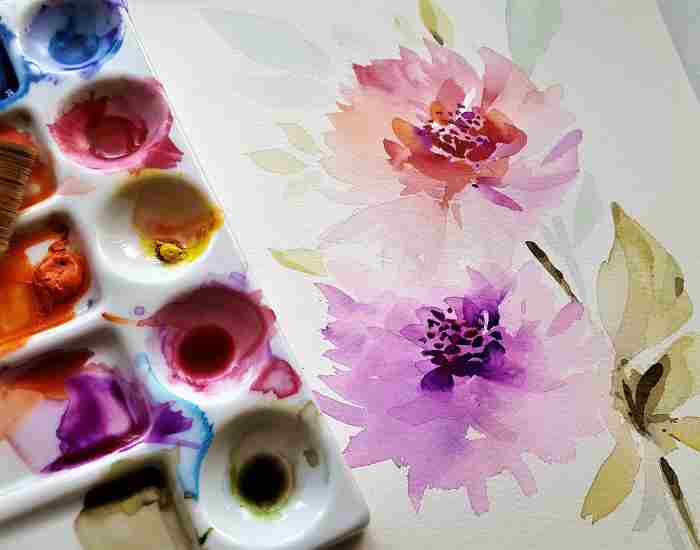Are you ready to embark on an exciting journey into the world of watercolor painting? Look no further than this comprehensive guide: the Newbie’s Handbook to Watercolor Painting Mastery.
This guide is designed specifically for beginners who are eager to learn the ins and outs of watercolor painting. Whether you’ve never picked up a brush before or you’ve dabbled in other mediums, this handbook will provide you with the foundational knowledge and techniques to start your watercolor journey with confidence.
By the end of this handbook, you’ll not only grasp the basics but also gain the confidence to create stunning watercolor masterpieces. From understanding the properties of watercolor paints to mastering various techniques and exploring your own unique style, this guide will equip you with the skills and knowledge needed to unlock your creative potential in the world of watercolor painting.

Getting Started with Watercolor Painting
Choosing the Right Supplies: Before you dive into the colorful world of watercolor painting, it’s crucial to have the right tools at your disposal. Let’s break down the essentials of your watercolor kit:
- Brushes: Invest in a variety of brushes, including round, flat, and detail brushes, to accommodate different strokes and details in your paintings. Consider the bristle type: natural hair brushes are excellent for watercolor as they hold more water and paint, while synthetic brushes are more durable and suitable for specific techniques.
- Paints: When it comes to watercolor paints, quality matters. Opt for professional-grade paints that offer vibrant pigments and good lightfastness. Start with a basic palette of primary colors—red, blue, and yellow—and gradually expand your collection as you explore different color combinations and techniques.
- Paper: The type of watercolor paper you choose can significantly impact the outcome of your paintings. Look for paper specifically designed for watercolor with a weight of at least 140lb (300 g) to prevent buckling and warping. Cold-pressed paper provides a textured surface that is ideal for creating a variety of washes and effects.
- Palette: A watercolor palette is essential for mixing and diluting your paints. You can opt for a traditional plastic palette or explore alternatives like ceramic or porcelain palettes, which offer a smoother mixing surface and easier cleanup.
With the right supplies in hand, you’re ready to embark on your watercolor painting journey with confidence.
Exploring Basic Techniques: Now that you have your supplies gathered, it’s time to dive into the fundamental techniques that form the backbone of watercolor painting. These techniques lay the groundwork for creating various effects and styles in your artwork. Let’s explore some of the basic techniques:
- Wet-on-Wet: This technique involves applying watercolor paint to a wet surface, resulting in soft, diffused edges and a blending of colors. It’s perfect for creating atmospheric effects and smooth transitions between hues.
- Wet-on-Dry: In contrast, wet-on-dry involves applying watercolor paint to a dry surface, allowing for more precise control over lines and details. This technique is ideal for adding fine details and sharp edges to your paintings.
- Blending: Mastering the art of blending is essential for creating seamless transitions between colors and achieving smooth gradients. Experiment with layering different colors while the paint is still wet, or use a clean, damp brush to blend edges and soften harsh lines.
Mastering Color and Technique
Color Theory:
Color theory forms the backbone of watercolor painting, guiding artists in creating harmonious compositions and vibrant artworks. Let’s delve into the basics of color theory and how you can apply it to your watercolor creations.
- Primary Colors: In color theory, there are three primary colors: red, blue, and yellow. These colors cannot be created by mixing other colors and serve as the foundation for all other hues.
- Secondary Colors: When you mix two primary colors together, you create secondary colors. For example, mixing red and yellow produces orange, blue and yellow create green, and red and blue yield purple.
- Tertiary Colors: Tertiary colors are created by mixing a primary color with a neighboring secondary color. This results in colors like red-orange, yellow-green, and blue-violet.
- Color Harmony: Understanding color harmony is essential for creating visually pleasing watercolor paintings. Harmonious color schemes include complementary colors (colors opposite each other on the color wheel), analogous colors (colors next to each other on the color wheel), and triadic colors (three colors evenly spaced on the color wheel).
By mastering color theory, you’ll gain a deeper understanding of how colors interact and how to create dynamic and engaging watercolor compositions.
Exploring Washes and Layers:
Washes and layers are fundamental techniques in watercolor painting, allowing artists to build depth, dimension, and complexity in their artworks. Let’s explore how you can utilize washes and layers to elevate your watercolor creations.
- Washes: A wash is a thin layer of diluted paint applied to the paper, typically used to cover large areas or establish a base color. There are different types of washes, including flat washes (uniform color across the surface), graded washes (gradation of color from dark to light or vice versa), and variegated washes (mix of colors applied in a random pattern).
- Layering: Layering involves building up multiple layers of paint to create depth, richness, and complexity in your watercolor paintings. Start with light washes and gradually add darker layers to deepen shadows, enhance details, and create visual interest.
- Glazing: Glazing is a technique where transparent layers of color are applied over dry layers of paint. This technique allows you to achieve subtle color variations and luminous effects in your watercolor artwork.
- Negative Painting: Negative painting involves painting around the subject to create shapes and forms by highlighting the space around them. This technique adds depth and complexity to your watercolor compositions.
Creating Depth in Your Artwork:
Adding depth and dimensionality to your watercolor paintings can transform them from flat images to immersive artworks that draw viewers in. Here are some tips and tricks to help you create depth in your artwork:
- Foreground, Middle Ground, and Background: Divide your composition into distinct layers—foreground, middle ground, and background—to create the illusion of depth. Objects in the foreground should appear larger and more detailed, while those in the background should be smaller and less defined.
- Atmospheric Perspective: Use atmospheric perspective to convey depth by gradually fading colors and details as objects recede into the distance. Cooler, lighter colors and softer edges can create the illusion of distance, while warmer, darker colors and sharper edges bring objects closer to the viewer.
- Overlap: Overlapping objects in your composition can create a sense of depth by indicating which objects are closer to the viewer and which are farther away. Experiment with overlapping shapes and forms to add visual interest and depth to your watercolor paintings.
- Linear Perspective: Linear perspective is a powerful tool for creating depth and spatial relationships in your artwork. Experiment with one-point, two-point, and three-point perspective to create the illusion of depth and space in your watercolor paintings.
By incorporating these tips and tricks into your artwork, you can create watercolor paintings that are rich in depth and dimensionality, captivating viewers and transporting them into your artistic world.
Playing with Perspective:
Perspective is a fundamental concept in art that can greatly enhance the realism and impact of your watercolor paintings. Understanding how perspective works and how to manipulate it can take your artwork to the next level. Here’s how you can play with perspective in your watercolor paintings:
- Foreshortening: Foreshortening is a technique used to create the illusion of depth by distorting the size and shape of objects as they recede into the distance. Experiment with foreshortening to create dynamic compositions and add visual interest to your watercolor paintings.
- Point of View: Consider the point of view from which your painting is viewed. Changing the point of view can dramatically alter the composition and perspective of your artwork, allowing you to create unique and engaging watercolor paintings.
- Scale and Proportion: Pay attention to the scale and proportion of objects in your watercolor paintings to create a sense of depth and space. Objects closer to the viewer should appear larger, while those farther away should appear smaller.
- Leading Lines: Use leading lines to draw the viewer’s eye into the painting and create a sense of depth and movement. Experiment with diagonal, curved, and converging lines to add visual interest and depth to your watercolor paintings.

Challenges and Developing Skills
In the world of watercolor painting, mistakes are not failures but rather valuable learning experiences that can propel your skills to new heights. Here’s why embracing mistakes is crucial for growth and improvement in watercolor painting:
- Learning Opportunity: Every mistake you make provides an opportunity to learn and grow as an artist. By analyzing what went wrong and how you can improve, you can develop a deeper understanding of watercolor techniques and refine your skills.
- Creativity: Mistakes often lead to unexpected outcomes and creative discoveries. Embrace the unexpected and allow mistakes to guide your creative process, leading to unique and innovative watercolor paintings.
- Resilience: Embracing mistakes fosters resilience and perseverance in the face of challenges. Instead of becoming discouraged by setbacks, view them as stepping stones on your journey to mastery and use them to fuel your determination and passion for watercolor painting.
- Experimentation: Mistakes encourage experimentation and exploration in your artwork. Don’t be afraid to take risks and try new techniques; you never know what amazing discoveries you might stumble upon along the way.
By embracing mistakes and viewing them as opportunities for growth and improvement, you can transform setbacks into successes and unlock your full potential as a watercolor artist.
How can consistent practice sharpen your skills and unlock your creative potential?
Like any skill, watercolor painting requires consistent practice to master. Here’s how regular practice can sharpen your skills and unlock your creative potential:
- Skill Development: Practice allows you to hone your technical skills and become more proficient in watercolor techniques such as brushwork, blending, and color mixing. The more you practice, the more confident and skilled you’ll become as a watercolor artist.
- Muscle Memory: Regular practice builds muscle memory, making it easier to execute complex brushstrokes and movements with precision and control. Over time, your hand-eye coordination will improve, allowing you to express yourself more freely and confidently in your watercolor paintings.
- Creative Exploration: Practice provides an opportunity to experiment with different styles, subjects, and approaches in your artwork. By pushing yourself out of your comfort zone and trying new things, you’ll expand your artistic horizons and discover new possibilities for expression in watercolor painting.
- Progression: Consistent practice leads to noticeable progression in your skills and abilities as a watercolor artist. Set goals for yourself and track your progress over time; you’ll be amazed at how far you’ve come and inspired to keep pushing yourself to new heights.
Conclusion
As you reach the end of this Newbie’s Handbook to Watercolor Painting Mastery, take a moment to reflect on the journey you’ve embarked upon. From learning the basics of watercolor painting to exploring advanced techniques, you’ve made incredible strides in your artistic development. Celebrate your progress and the growth you’ve experienced as a watercolor artist.
As you continue on your watercolor painting journey, remember that mastery is not a destination but a lifelong pursuit. Keep pushing yourself out of your comfort zone, experimenting with new techniques, and exploring different subjects and styles. Embrace the creative process, and don’t be afraid to make mistakes; they’re opportunities for growth and learning. Most importantly, have fun with your newfound skill and let your passion for watercolor painting guide you on your artistic adventure.
